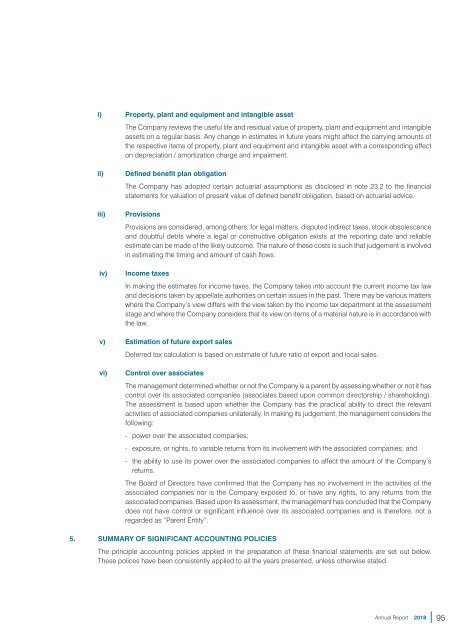MS AR 2018 (1)
Create successful ePaper yourself
Turn your PDF publications into a flip-book with our unique Google optimized e-Paper software.
i) Property, plant and equipment and intangible asset<br />
The Company reviews the useful life and residual value of property, plant and equipment and intangible<br />
assets on a regular basis. Any change in estimates in future years might affect the carrying amounts of<br />
the respective items of property, plant and equipment and intangible asset with a corresponding effect<br />
on depreciation / amortization charge and impairment.<br />
ii)<br />
iii)<br />
iv)<br />
Defined benefit plan obligation<br />
The Company has adopted certain actuarial assumptions as disclosed in note 23.2 to the financial<br />
statements for valuation of present value of defined benefit obligation, based on actuarial advice.<br />
Provisions<br />
Provisions are considered, among others, for legal matters, disputed indirect taxes, stock obsolescence<br />
and doubtful debts where a legal or constructive obligation exists at the reporting date and reliable<br />
estimate can be made of the likely outcome. The nature of these costs is such that judgement is involved<br />
in estimating the timing and amount of cash flows.<br />
Income taxes<br />
In making the estimates for income taxes, the Company takes into account the current income tax law<br />
and decisions taken by appellate authorities on certain issues in the past. There may be various matters<br />
where the Company’s view differs with the view taken by the income tax department at the assessment<br />
stage and where the Company considers that its view on items of a material nature is in accordance with<br />
the law.<br />
v) Estimation of future export sales<br />
Deferred tax calculation is based on estimate of future ratio of export and local sales.<br />
vi)<br />
Control over associates<br />
The management determined whether or not the Company is a parent by assessing whether or not it has<br />
control over its associated companies (associates based upon common directorship / shareholding).<br />
The assessment is based upon whether the Company has the practical ability to direct the relevant<br />
activities of associated companies unilaterally. In making its judgement, the management considers the<br />
following:<br />
- power over the associated companies;<br />
- exposure, or rights, to variable returns from its involvement with the associated companies; and<br />
- the ability to use its power over the associated companies to affect the amount of the Company’s<br />
returns.<br />
The Board of Directors have confirmed that the Company has no involvement in the activities of the<br />
associated companies nor is the Company exposed to, or have any rights, to any returns from the<br />
associated companies. Based upon its assessment, the management has concluded that the Company<br />
does not have control or significant influence over its associated companies and is therefore, not a<br />
regarded as “Parent Entity”.<br />
5. SUMM<strong>AR</strong>Y OF SIGNIFICANT ACCOUNTING POLICIES<br />
The principle accounting policies applied in the preparation of these financial statements are set out below.<br />
These polices have been consistently applied to all the years presented, unless otherwise stated.<br />
Annual Report <strong>2018</strong><br />
95


